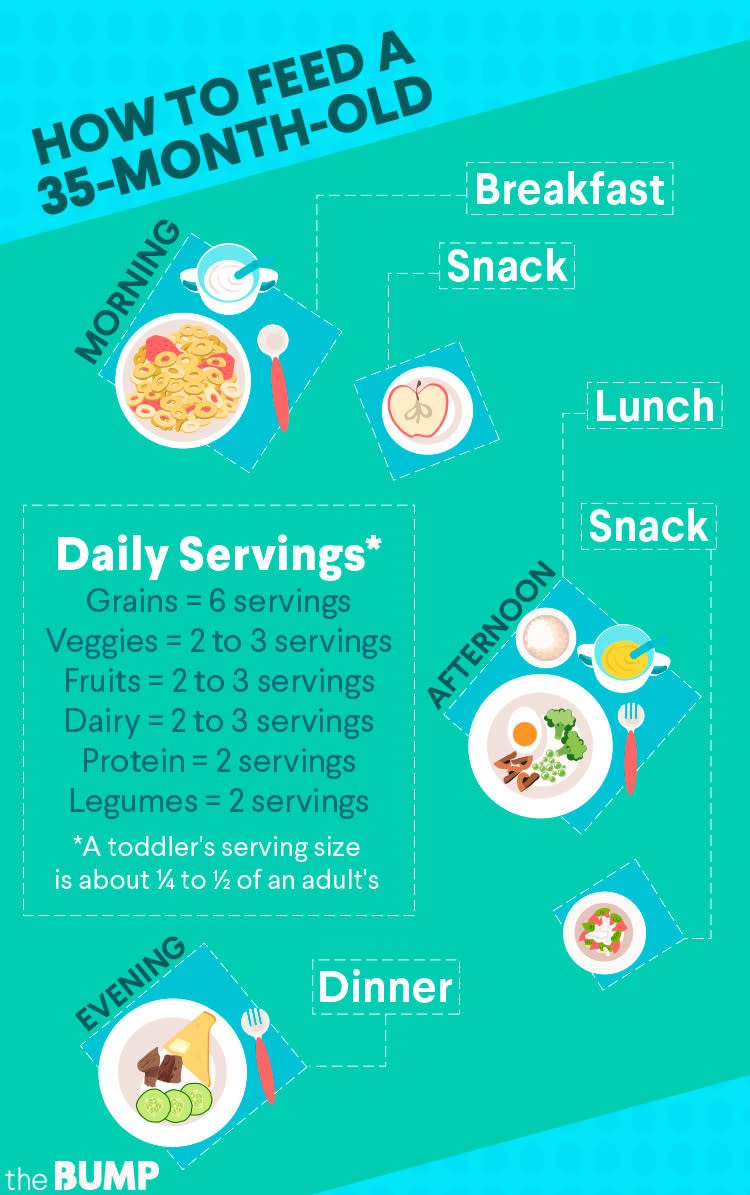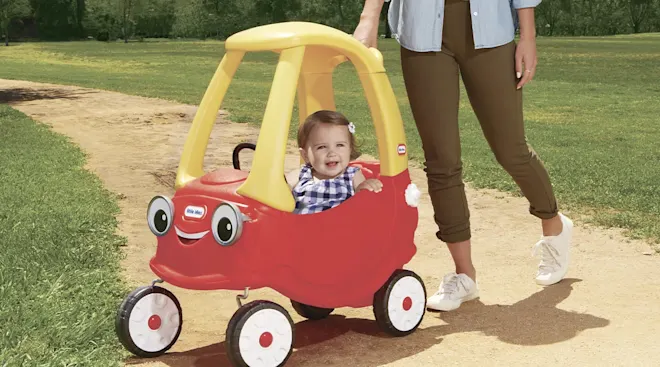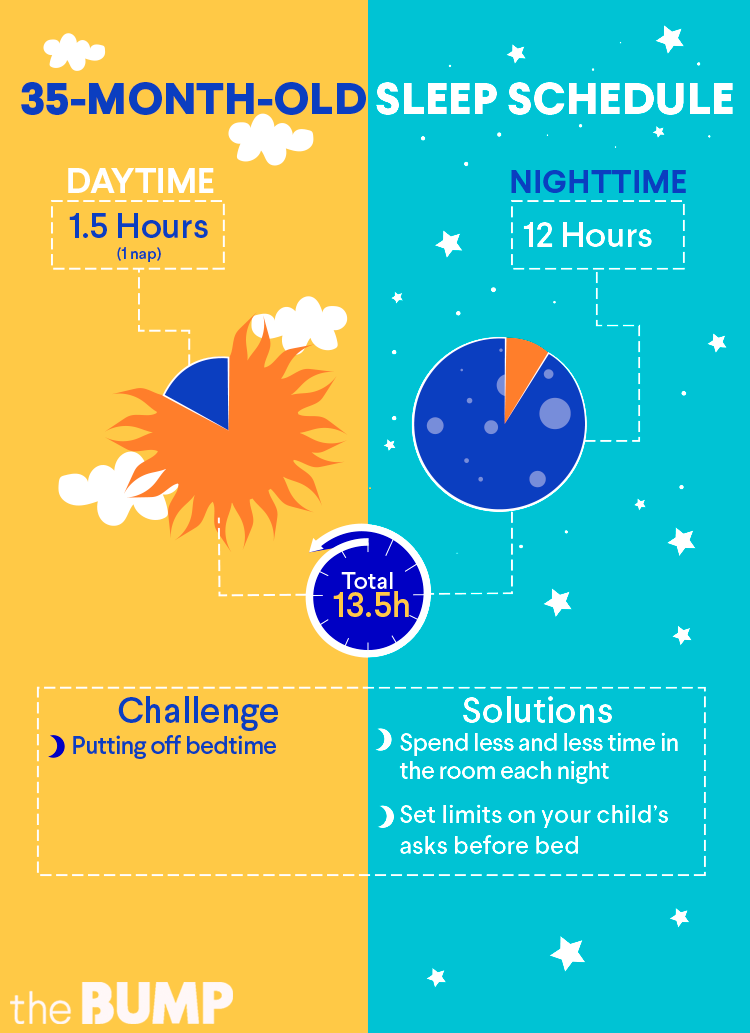As your 35-month-old baby nears their third birthday, they’re likely talking a mile a minute and collecting everything they can get their hands on. It’s an exciting time as they continue to learn and grow each day. Along the way, though, you may notice your child developing certain behaviors like choosing a favorite parent or putting off bedtime. Is this normal? And what should you do about it?
In our 35-month-old guide, you’ll find key insights into your toddler’s development, behavior, sleep schedules and meal routines. We also provide a handy checklist to help you stay on track with your toddler’s progress.
Your growing 35-month-old is mastering lots of new skills and getting more independent by the minute.
35-Month-Old Weight & Height
Average weight for a 35-month-old is around 30.4 pounds for girls and 31.4 pounds for boys. Average height is around 36.9 inches for girls and 37.3 inches for boys, according to the US Centers for Disease Control and Prevention (CDC).
35-Month-Old Milestones
“What should my 35-month-old be doing?” you ask? Every day is a new adventure with your little one as they hit their 35-month-old milestones. Check out the following milestones they may be achieving this month:
- Speech. Your child probably has at least 200 words, and they most likely speak more clearly than they once did. They’re starting to grasp the different pronouns (he, she, we, it, etc.). What a little smarty-pants!
- Motor skills. Your 35-month-old child can probably put on at least one piece of clothing, stand on one foot and draw a straight(ish) line. They may now have the coordination required to pedal a tricycle— if not, they might scoot along with their feet on the ground. They'll get it with practice.
- Potty training. When it comes to potty training, 35-month-olds are a mixed bag. Some are trained, some are in the process and some aren't quite ready yet. If your child is resisting the potty, avoid the urge to put on the pressure. While you may be in a hurry to ditch the diapers, pressing could actually cause more harm than good. It may benefit everyone to put a pause on potty training for a few weeks before trying again.
35-Month-Old Behavior
- Independence. You may be able to (finally!) convince your child to play on their own for short stretches, which could feel a bit freeing for you.
- Playing favorites. Your child may be acting as if they like you better than their other parent or vice versa. Don’t get offended—it's just a phase, and the roles will reverse at some point.
Health is always a top concern for parents, and this age is no different. Some common health questions parents of 35-month-olds have are:
- My 35-month-old has diarrhea. What should I do?
- My 35-month-old is constipated. What should I do?
- My 35-month-old is throwing up. What should I do?
- My 35-month old has a cough. What should I do?
- My 35-month-old has a fever. What should I do?
The biggest thing to remember when feeding your 35-month-old is that they’re probably the best judge of their appetite. And they need to eat a variety of healthy foods, just like you do. Salty and sugary snacks should be saved for special occasions.
How Much Should My 35-Month-Old Be Eating?
Two-year-olds should continue to eat three meals per day, plus two snacks. Offer your child a variety of foods in all food groups—vegetables, fruits, grains, protein and dairy—daily. Portion size isn't big at this age: Expect your kid to eat only ¼ to ½ as much as an adult.
Your 2-year-old should be drinking 1 percent or skim milk (not whole milk). Try to offer low-fat dairy products too, such as yogurt and cheese. Doctors recommend kids ages one to 3 get 700 mg of calcium per day. Fat should account for less than 30 percent of your toddler's daily calories.
What to Feed My 35-Month-Old
Looking for some tasty and nutritious meal inspiration? Check out these food ideas for a 2-year-old:
35-Month-Old Feeding Schedule
35-Month-Old Eating Problems
Mealtime with a 35-month-old can easily become a power struggle—don't let it! Offer nutritious food and keep serving small amounts of new foods. But don't force your child to eat or expect them to love anything you give them. Even if your toddler was crazy about it yesterday. And remember, it can take up to 20 instances of exposure to a food before a child develops a liking for it.
You may notice your 35-month-old is starting to sleep a little less during their daytime nap. That's totally normal. Most kids this age do still need a nap but may be gradually and naturally weaning themselves off them.
How Much Sleep Does a 35-Month-Old Need?
Most 2-year-olds need around 11 to 12 hours of nighttime sleep, plus a nap of about 1.5 to 3 hours, for a total of about 13 to 14 hours of sleep per day.
35-Month-Old Sleep Schedule
Every kid is different, but your child's schedule may look something like this:
35-Month-Old Sleep Problems
It's common for 35-month-olds to try to put off bedtime as long as possible. While it's sometimes adorable that your child wants you to read five more stories and give you 10 more kisses, it's also exhausting. To avoid letting it get out of control, stay calm and remind them of the bedtime routine. Set limits on just how many times you come back to their bedroom and how many extra little things you'll do for your child before they finally go to sleep.
Give your 35-month-old plenty of time to play freely and to play outside. Play helps them learn and keeps their body active and healthy.
Wondering what to do with a 35-month-old? Fun activities, games and toys for a 35-month-old are:
- Tricycle. Your 35-month-old will soon be developmentally ready to master pedaling a tricycle, if they haven’t already. And yes, it's important that they wear a helmet while riding, even though they seem so close to the ground.
- Collecting. Kids this age love to collect acorns, pine cones, rocks, action figures…you name it. This is a fun activity to do together and can help your 35-month-old learn about the world around them and practice sorting and organization. If it's something low-cost or free, even better!
- Pretend play. Playing house, school, grocery store or kitchen helps 35-month-olds understand different roles and can help them develop emotionally.
- Handle weird phases (like barking like a dog!) like they’re no big deal, so long as they don’t interfere with normal activities. Just explain that it’s a thing they can do at some times but can’t at others. And get it on video, of course.
- Going to the grocery store or a Target run with your 35-month-old can be an ordeal. They want every cool-looking thing they see! And as much as you want to make your kiddo happy, saying no can set the precedent that they won't get everything they whine or beg for.
- Remember: Next month is your child's 3-year-checkup. Call the doctor and make an appointment if you didn't at your last visit.
- Don’t freak out if you catch your child lying—it doesn't mean they’re destined for a life of crime. A child’s first lie is actually a significant developmental milestone. To lie, a child needs good verbal skills, plus enough imagination to be able to invent an alternate reality. They probably get that telling the truth would disappoint someone, which shows an understanding of expectations and emotions. So instead of punishing your child for lying, try gently confronting them with the truth. (“I see cookie crumbs on your face,” for instance.) Talk briefly about the importance of telling the truth, but don’t lecture your toddler too much.
- Now more than ever, you might be tempted to place your 35-month-old baby in front of a screen to watch shows or play games. However, experts recommend no more than one hour of screen time a day for toddlers. Remember, screen time involves viewing content on tablets and smartphones too, not just television screens.
- Your 35-month-old has a special birthday coming up! If you’re planning a third birthday party where other children are invited, be sure to consider all the safety elements. Host the party at a toddler-proof location and serve child-friendly food that doesn’t pose any choking hazards.
- It’s never too soon to start introducing letters and numbers to a 35-month-old. When reading books together, point out letters and words and encourage your toddler to count the animals on each page. You can also invest in magnetic letters and numbers for the fridge or foam versions for bathtime.
- While it can be difficult saying no to a 35-month-old toddler, it must be done. Toddlers need to learn that they cannot get their way all the time, especially when they employ crying and whining. The good news? Telling your child no can help them develop self-control and patience.
- Are you and your partner disagreeing on certain aspects of raising your toddler? It’s understandable not to be aligned on everything, but it’s important to talk through these issues and find a compromise. Also, be sure to create a united front when addressing your toddler so you’re not creating a confusing environment for them.
Your toddler is likely hitting their 35-month-old milestones left and right. You two have had quite the adventure together so far, and you have many more milestones to look forward to in the near future.
Please note: The Bump and the materials and information it contains are not intended to, and do not constitute, medical or other health advice or diagnosis and should not be used as such. You should always consult with a qualified physician or health professional about your specific circumstances.
Navigate forward to interact with the calendar and select a date. Press the question mark key to get the keyboard shortcuts for changing dates.















































